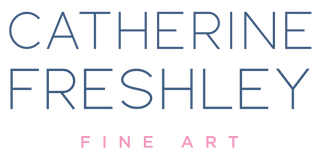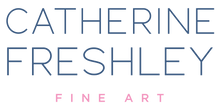My Favorite Art Supplies
Thinking of painting for the first time? Curious to see what another professional artist is up to? I have been painting for a long time and on this page, I share all of my favorite paint colors and supplies.
If you would like to purchase some of these supplies online through Dick Blick (my favorite art supply store), I have added all the paint colors, the palette knife and the “life-saving” Sta-Wet palette to a shopping cart on Blick’s website; you can edit the cart before you purchase. You can also look at the products individually by clicking on the links throughout this page.
If you purchase something from Blick after clicking on one of my links, I will earn a small commission. You will not pay any extra, it’s just a little thank you from Blick to me for sending the business their way. I hope you will consider purchasing through my links; it is a way for you to support me that does not cost a dime or any extra time. Thank you.
Whenever you can, buy professional quality paints; though they are significantly more expensive than student-grade or craft paint, professional quality paints are thicker and much richer in pigment. You definitely get what you pay for. I always buy Liquitex and Golden heavy-body acrylics. If you do not plan to buy all top-tier paint, prioritize your key colors.
For the paints I use the largest quantities of — white, blue, yellow, Payne’s Gray — I buy huge jugs. I buy other colors in either 2 oz or 5 oz tubes. Paint goes a long way, so if you are just getting started, I recommend the 2 oz tubes. For instance, I use orange and cadmium red light frequently, but I never need a lot, so I buy the small tubes.
To get started, I recommend the following colors — they are my favorites and the ones I use the most often. This gives you all your primary colors, plus white and “black”:
- Titanium white
- Payne’s Gray — This is a very dark navy that you can often use in place of black; also, I love mixing a little of this with cadmium yellow to make fantastic greens.
- Hansa yellow opaque
- Cobalt blue — Similar to royal blue; will tint to a nice “baby blue” or periwinkle when you add a little purple.
- Phthalo blue - green shade — Very intense color, will tint to a sky blue.
- Quinacridone crimson — Deep red, makes a nice pink when mixed with white or a nice brown when mixed with Hooker’s Green.
- Cadmium-free red light — This mixed with white makes gorgeous sunset coral colors; also try mixing a tiny bit of this and cobalt with white to get the perfect evening sky color.
- Titanium buff/unbleached titanium — Excellent in place of white to make soft, muted colors.
Additional colors to consider:
- Hooker’s green (nice dark green)
- Cadmium-free orange — I love this orange for sunrises and sunsets and find that it is hard to make something similar with yellow and red.
- Medium magenta — Great to have at my disposal for sunrises and sunsets.
- Dioxazine purple — It is hard to get a nice, vibrant purple by mixing red and blue; I am rarely looking for a vibrant purple, but when I am, I use this.
- Burnt umber (brown)
- Raw sienna — Nice, warm tan color; mixes well with phthalo green to mute the green.
Note: Look for cadmium colors that say “cadmium free” or “cadmium hue” to avoid buying paints with toxic cadmium.
For my mini paintings, I use a mix of acrylic and gouache. Gouache is an opaque watercolor paint and I like it for its opacity and chalkiness. You can shop Blick’s gouache paints here.
I do not buy expensive brushes; I tend to wear them out quickly and it is much more important to buy good quality paint and canvas than to invest in brushes.
- There are many shapes of brushes; I primarily use flat brushes and angular flat brushes. This image shows the brushes I use most often.
- Choose a range of shapes and sizes, ensuring you have some with which you can make a nice edge or line.
- The 3” brush in this set (shown on the right in my photo) is great for covering large areas. I use this or a 4” brush for prepping my canvases and painting the background of the sky.
- This large filbert brush is great for large, puffy clouds.
- I use 1” flat wash brushes (blue-handled one in the middle of the photo) all the time for filling in clouds and land areas.
- Angle shaders are my favorite. I use them in 1/4,” 3/8,” and 1/2” sizes. I love them because you can use the full brush to make a larger mark or just the edge to make a nice line. These are key for cloud and vegetation details.
- Last, I use a tiny round brush for fine details and signing my name.
- Sta-Wet palette — Using this palette will allow you to keep your paint wet and workable while painting and even between painting sessions.
- Palette knife — I use these to mix paint on my canvas
- Gel medium: Medium is basically clear paint, and it comes in different viscosities and sheens. Use fluid medium to thin paint and make it partially translucent for washes/varnishes, to extend drying time, to get complete coverage on canvas, or stretch quantity of paint; use heavy or super heavy gel medium to thicken paint and give and give it more texture.
Many artists stretch their own canvases, but I do not; I like to have as much time to actually paint as possible.
- I buy Blick’s “premier” level cotton canvases.
- “Gallery profile” means the canvases are 1.5” deep.

